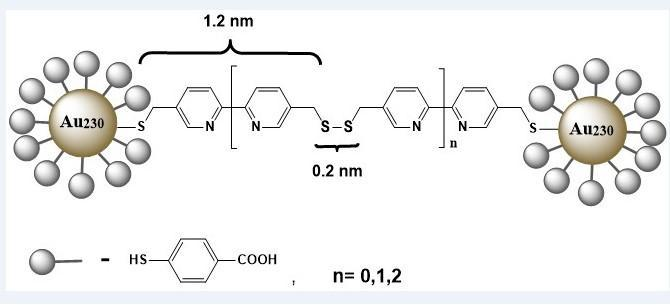Feb 6 2020
A recent pathbreaking study could be useful for the synthesis of catalysts and chemical sensors based on gold nanoclusters. Chemists from the University of Jyväskylä, Finland and the University of California have successfully determined the exact atomic structure of a chain of gold nanoclusters bound to one another.
 Suggested structure of two Au230 nanoclusters linked by 5,5'-bis(mercaptomethyl)-2,2'bipyridine (BMM-BPy) dithiols. Image Credit: The University of Jyväskylä/Karolina Sokolowska. Image credit: EurekAlert
Suggested structure of two Au230 nanoclusters linked by 5,5'-bis(mercaptomethyl)-2,2'bipyridine (BMM-BPy) dithiols. Image Credit: The University of Jyväskylä/Karolina Sokolowska. Image credit: EurekAlert
As part of their research, the scientists unraveled the disulfide-bridging bond between the attached nanoclusters. Interconnected gold nanocluster structures improve researchers’ insights into the electronic and optical response of these systems, which could find potential applications in the fields of nanoelectronics and bioimaging in the future. The research was reported in The Journal of Physical Chemistry Letters in January 2020.
These structures are actually huge molecules that were studied by scientists from the Nanoscience Center of the University of Jyväskylä four years ago. They were the first in the world at the time to create a chain of gold forged with atomic precision, which was termed the world’s smallest gold chains (Nanoscale, 2016).
In a most recent study of individual bonds using spatially resolved imaging, scientists analyzed the structure of the chain with atomic precision and experimentally confirmed that the gold nanoparticles are connected together by bridging disulfide bonds. To date, the proof of disulfide linking was a speculated subject.
Modifying the surface of nanoclusters and the molecules connecting them is a step closer to new biological, medical and electronic applications.
Docent Tanja Lahtinen, Researcher, University of Jyväskylä
A chain of linked nanoscale gold particles reacts with light.
In these nanoscale superstructures, the electron clouds of the metal particles of adjacent particles are interconnected, opening up the possibility of studying the interactions between particles with very accurate theoretical calculations, now that we know, for sure, how the structures have formed.
Eero Hulkko, Researcher, University of Jyväskylä
The Atomic Precise Structure was Revealed by Combining Imaging Techniques
Thanks to the study of nanoscale chemical structures, there has been a spur in the fast development of chemically selective imaging methods. Equipment with very high sensitivity and resolution is required for the atomic resolution of individual molecules.
In this study, the most advanced transmission electron microscopy (TEM) technology was employed.
The JEM-ARM300F Grand ARM TEM equipment that was used for the measurements is housed at the IMRI center, University of California, which currently has the most sophisticated commercially available electron microscopy equipment.
This study combined high-resolution electron microscopy (TEM) with high-sensitivity electron energy loss spectroscopy (EELS), which allowed simultaneous structural and spectroscopic analysis to determine the nanoscale structure, with X-ray photoelectron spectroscopy (XPS) analysis supported by the above-mentioned data.
Karolina Sokolowska, Researcher, University of Jyväskylä.